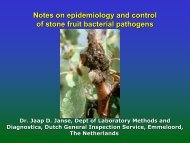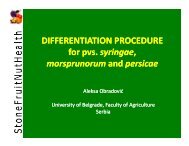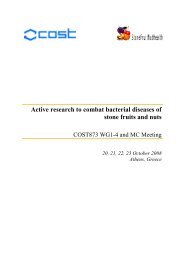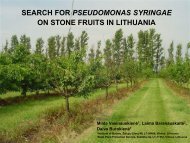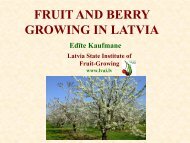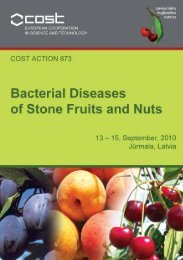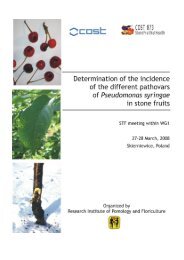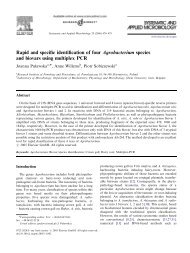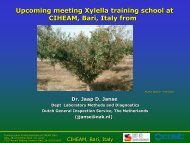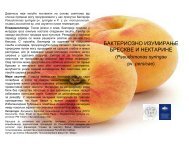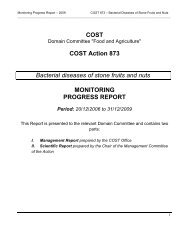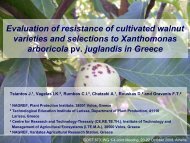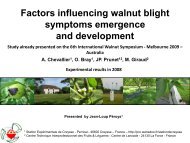Obtención de portainjertos de cerezo (Prunus avium L ... - Cost 873
Obtención de portainjertos de cerezo (Prunus avium L ... - Cost 873
Obtención de portainjertos de cerezo (Prunus avium L ... - Cost 873
Create successful ePaper yourself
Turn your PDF publications into a flip-book with our unique Google optimized e-Paper software.
Security measures for sending bacterial free plant materials.<br />
Gregorio López, José Cos, Antonio Carrillo, Carmen<br />
Frutos, Alfonso Guevara, Domingo Ortiz, Diego Frutos
in vitro or in vivo, for sending plant material?<br />
ADVANTAGES<br />
Big number of plants in small parcels<br />
Avoiding contaminations during travel.<br />
ADVANTAGES<br />
Plants more easy of grow, bigger size<br />
UNCONVENIENTS<br />
Sanitary control<br />
UNCONVENIENTS<br />
Risks of mutations<br />
Introduction<br />
In Vitro<br />
In Vivo
Stages of in vitro culture Introduction<br />
Stage 5: Adaptation<br />
Growers<br />
Stage 0: Plant material<br />
Stage 4: Rooting<br />
Stage 1: Establishment<br />
Micropropagation Stages<br />
Stage 3:<br />
Multiplication<br />
Stage 2:<br />
Proliferation<br />
Lab
Sweet cherry seeds (<strong>Prunus</strong> <strong>avium</strong> L.) teguments effects.<br />
Introduction
Influence of seeds teguments on sweet cherry (<strong>Prunus</strong> <strong>avium</strong> L.)<br />
germination.<br />
Objetives<br />
Cultivars studied: Burlat, 4-70 and Ruby M. & M.<br />
2,4 gr/l WPM + 30 g sucrose/l. (PH=5,7). + Agar (PPA) 6,5 g/l.<br />
5 Minutes<br />
Sterilized<br />
water<br />
10 Minutes<br />
Shaking
CONTAMINACIÓN<br />
Means and 95,0 Percent Tukey HSD Intervals<br />
1,4<br />
1,3<br />
1,2<br />
1,1<br />
1<br />
N S<br />
Tegumentos<br />
1.- More germination without teguments, in<strong>de</strong>pen<strong>de</strong>ntly of treatments and age of<br />
seeds [ 1,2,3 ].<br />
2.- More contamination with teguments,in<strong>de</strong>pen<strong>de</strong>ntly of treatments, cultivars and<br />
age of seeds.<br />
3.- Young seeds (E1) presented the lesser contaminations percents.<br />
4.- Significative <strong>de</strong>ifferences were found between cultivars and treatments.<br />
Results<br />
Conclusions
Introduction<br />
Sweet cherry rootstock (<strong>Prunus</strong> <strong>avium</strong> L.) by in vitro grafting.
Cherry rootstocks for the Region of Murcia Introduction<br />
Peach x Almond<br />
hybrid GxN15<br />
Santa Lucía 64<br />
(<strong>Prunus</strong> mahaleb)<br />
Sweet cherry<br />
cultivar<br />
Adara<br />
(<strong>Prunus</strong> cerasífera L.)<br />
Hybrid (Peach x<br />
Almond) + Adara<br />
(Frutos and Ureña 2008) (Frutos and Ureña 2008)<br />
(Frutos and Ureña 2009)
Advantages of in vitro graft versus graft in vivo Introduction<br />
Free Plantas diseases libres<br />
plant virus material<br />
Incompatibilidad<br />
Graft-roostock<br />
incompatibility<br />
patrón-injerto<br />
High<br />
percentages<br />
Elevados<br />
porcentajes <strong>de</strong><br />
of prendimiento<br />
successful<br />
grafts<br />
Advantages<br />
Ventajas<br />
Small room<br />
Espacio recuired reducido<br />
Not subject Evita to<br />
condicionamiento<br />
seasonal<br />
conditions estacional<br />
Reducción Reduction riesgos in<br />
importación risk of <strong>de</strong><br />
material importation vegetal of<br />
plant material
in vitro growth conditions<br />
Photoperiod<br />
Fotoperiodo<br />
16 h light/ 8h<br />
• 16h luz/8h<br />
darkness<br />
oscuridad<br />
Temperature<br />
Temperatura<br />
• 25 ± 1 ºC<br />
Cámara<br />
climática<br />
fase in<br />
vitro<br />
Climatic room<br />
Lighting<br />
Iluminación<br />
• 45 µ mol m -2 s -1<br />
(Philips TLD<br />
58W/54)<br />
Material and methods
Free diseases plant material Material and methods<br />
GxN15<br />
Rooting<br />
15 days<br />
½ MS nutrients<br />
concentration + 2 mg/l IBA<br />
Murashige<br />
y Skoog<br />
(MS)<br />
0,75 mg/l BAP<br />
0,1 mg/l IBA<br />
30 g/l sacarosa<br />
6,5 g/l Bacto<br />
Agar<br />
Grafting after 30 days<br />
of growing<br />
MS<br />
Adara
Grafts successness Result<br />
% Successful l Graft<br />
Grow<br />
regulators<br />
Concentration (mg/l)<br />
Control<br />
0 0,25 0,5 2,5 5 Average<br />
BAP - 79,17 66,67 54,17 60,42 62,50 a<br />
GA3 - 62,50 83,33 56,25 52,08 60,42 a<br />
IBA - 75,00 79,17 58,33 64,58 66,67 a<br />
Control 65,28 - - - - 65,28 a<br />
Average 65,28 abc 72,22 bc 76,39 c 56,25 a 59,03 ab
Sprouting of Adara and Graft Successness<br />
% Adara Sprouting<br />
Grow<br />
regulators<br />
Concentration (mg/l)<br />
0 0,25 0,5 2,5 5 Total<br />
BAP - 54,17 45,83 33,33 39,58 40,97a<br />
GA3 - 20,83 50,00 33,33 56,25 41,67a<br />
IBA - 75,00 41,67 29,17 29,17 38,89a<br />
Control 41,67 - - - - 41,67a<br />
Total 41,67ab 50,00b 45,83ab 31,94a 41,67ab<br />
Results y Discussion
Conclusions<br />
- In vitro grafting technique is suitable for cherry rootstocks<br />
adapted to growing conditions as the Region of Murcia.<br />
- With this technique can be prepared rootstocks at any<br />
time of year, and for shorter time length than whit classical<br />
procedures.<br />
- Applying IBA at 0,25 mg/l gave the best percentage an the<br />
best quality of grafted plants.
Walnut propagation (Juglans regia L.) by in vitro<br />
or Small Grafting Technology?.<br />
Introduction
Stages of in vitro culture Introduction<br />
Stage 5: Adaptation<br />
Growers<br />
Stage 0: Plant material<br />
Stage 4: Rooting<br />
Stage 1: Establishment<br />
Micropropagation Stages<br />
Stage 3:<br />
Multiplication<br />
Stage 2:<br />
Proliferation<br />
Lab
Cuadro 1.- Número <strong>de</strong> amentos sobre el total <strong>de</strong> yemas <strong>de</strong> flor en muestras <strong>de</strong> 20 ramos por árbol en cultivares<br />
<strong>de</strong> nogal injertados y enraizados in vitro contados el día 15 <strong>de</strong> Julio <strong>de</strong> 2002.<br />
Injertados sobre Juglans regia (10ª hoja)<br />
Enraizados In vitro<br />
Varieda<strong>de</strong>s Amentos Yemas % amentos Amentos Yemas % amentos<br />
Femeninas (**) femeninas<br />
Serr 79 75 51 a 0 125 0<br />
Sunland 62 60 50a 0 159 0<br />
Fernet (*) 45 82 35ab 0<br />
Chandler 32 106 23b 0 126 0<br />
Total 218 324 42 0 500 0<br />
(*) Fernet en 3ª hoja / Chandler <strong>de</strong> cultivo in vitro en 7ª hoja. (**)Diferencias significativas entre cifras acompañadas<br />
<strong>de</strong> distinta letra<br />
Testigo nº 2.- Cotiledonar graft of<br />
cultivar Chandler /J. regia. In two<br />
moth, we can observed catkin.<br />
Cuadro 2.- Número <strong>de</strong> ramos florales con al menos un amento diferenciado el día 15 <strong>de</strong> julio <strong>de</strong><br />
2002 en varieda<strong>de</strong>s <strong>de</strong> nogal ubicadas en El Chopillo, Murcia.<br />
Introduction<br />
Unconvenients of in vitro propagation vs. grafting in vivo, in Juglans regia L.<br />
Growth regulators used in vitro culture <strong>de</strong>layed walnut pollen production.<br />
Consequently, start of production in orchard was also <strong>de</strong>layed.<br />
Injertadas sobre Juglans regia Enraizadas in vitro (7ª hoja)<br />
Varieda<strong>de</strong>s Ramos con amentos % Ramos con amentos %<br />
sobre total <strong>de</strong> ramos sobre total <strong>de</strong> ramos<br />
Serr 20/20 100 (1) 0/20 (2) 0<br />
Sunland 20/20 100(1) 0/20 (2) 0<br />
Fernet 15/20 75(3)<br />
Chandler 13/20 65(1) 0/20(2) 0<br />
Total 68/80 85 0/60 0<br />
Source: Frutos, D. 2003. Diferenciación floral en vergel <strong>de</strong> los cultivares <strong>de</strong> nogal<br />
(Juglans regia L.) enraizados in vitro. Actas <strong>de</strong> Horticultura 39:271-273.
7 Th leaf<br />
Introduction
Early works Introduction<br />
Firt walnut graftings were ma<strong>de</strong> by rapprochement (Mortillet, 1863)<br />
Size of scion<br />
Walnut scion quality was essential for succeeding (Germain and Jalinat,<br />
1974)<br />
Patch budding has been the most used method un France. Big scions size.<br />
Mother plants for scions are required (Bergougnoux and Lapierre, 1975)<br />
Strong prunning of 3-4 years-old limbs increase 5-6% percentage of profitable<br />
bads for budding (Novak, 1974)<br />
Small scions allowe using small rootstocks too. Small size seems to be<br />
more efficient that big one in walnut grafting propagation
Temperature Introduction<br />
Walnut takes need good temperaure conditions (Corsa, 1896; Olivier,<br />
1901)<br />
Optimal temprature for walnut grafting is 27-28 ºC (Sitton, 1931)<br />
Sittons temperature was used by Hartmann (1974) in forcing walnut grafts<br />
into humi<strong>de</strong> peorlite for 3 weeks<br />
Others authors, (Tusurkan adn Chebotar, 1972, Ristevski and Georgiev,<br />
1977; Shanma and Dhuria, 1981), kept walnut graftings into sawdust or<br />
polyethylene bugs for 10 -12 days.<br />
Grafting takes were improved by mean of a white plastic tent (Lagerstedt and<br />
Roberts, 1974)
Small Graft Technology
SGT
SGT
Security measures for sending bacterial free plant materials.<br />
Gregorio López, José Cos, Antonio Carrillo, Carmen<br />
Frutos, Alfonso Guevara, Domingo Ortiz, Diego Frutos<br />
Thanks for your attention!




